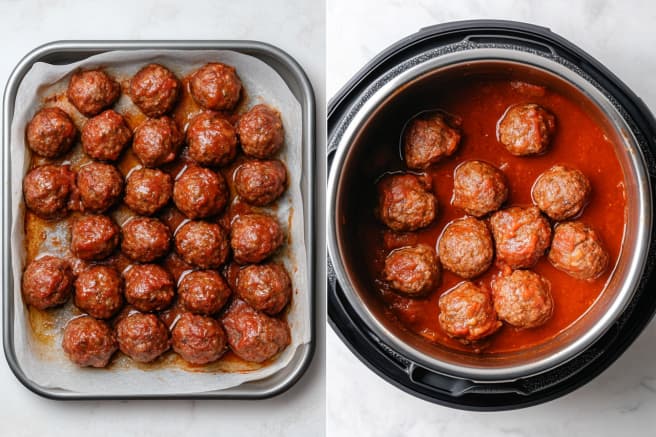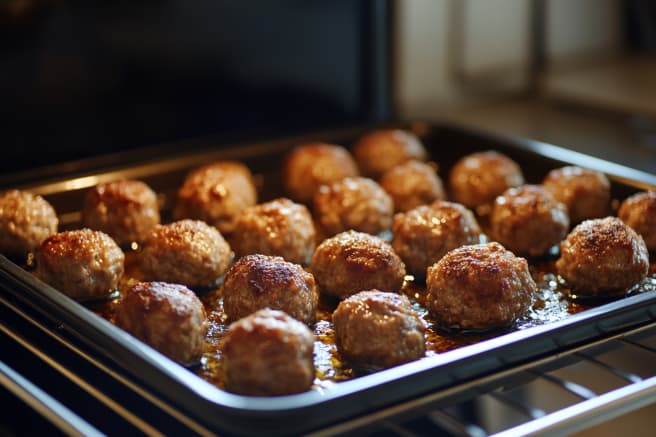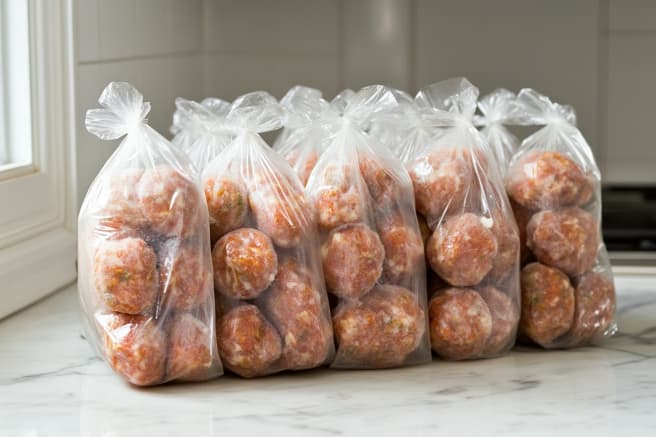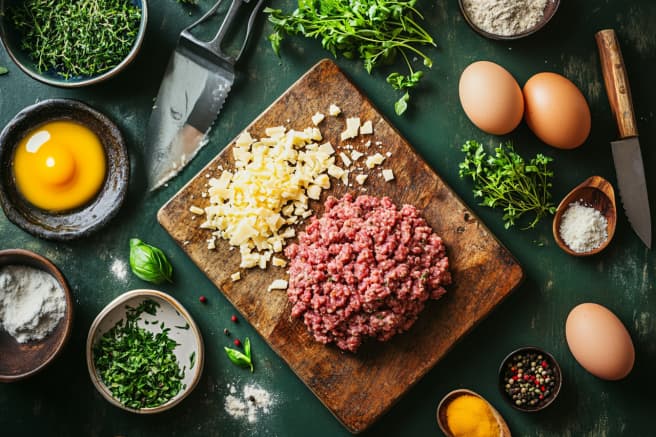Introduction to Ground Beef and Sausage Meatballs
Meatballs have long been a favorite dish for their versatility and flavor-packed nature. Among the myriad of variations, ground beef and sausage meatballs stand out for their rich taste and perfect texture. Combining these two meats offers a hearty and savory experience, making them a go-to option for countless families and gatherings. Whether served with pasta, in soups, or as appetizers, these meatballs are always a crowd-pleaser.
But why mix ground beef and sausage? The answer lies in balance. Ground beef provides structure and a beefy flavor, while sausage adds seasoning, moisture, and fat content for a melt-in-your-mouth bite. This combination ensures a harmonious blend that’s hard to replicate with a single meat source. Furthermore, these meatballs work well in cuisines like Italian, American, and Asian, showcasing their adaptability and universal appeal.
These delectable spheres of goodness are not only delicious but also straightforward to make. With the right ingredients and techniques, anyone can master the art of making perfect ground beef and sausage meatballs. Dive into this recipe and uncover their origins, preparation secrets, and pairing tips to elevate your cooking game.
The History of Meatballs: From Tradition to Modern Favorites
Meatballs may seem like a modern comfort food, but their roots stretch back centuries. Originating from different cultures, they were created as an efficient way to utilize meat trimmings mixed with fillers. From the Italian “polpette” to Swedish meatballs and the Middle Eastern “kofta,” the concept of rolled minced meat has universal significance.
The use of sausage in meatballs didn’t emerge until later, as recipes evolved to enhance flavor and moisture. In traditional Italian-American cooking, chefs began blending ground beef with Italian sausage to create meatballs with added seasoning and fat content. This adaptation allowed the dish to transition beyond basic sustenance into a celebrated delicacy.
Today, ground beef and sausage meatballs have become a staple in many home kitchens. This evolution reflects modern palates, craving bolder flavors and varied textures. Recipes now include ingredients like cheese, unique spices, or even plant-based versions, proving meatballs can cater to diverse dietary preferences while staying true to their original purpose.
Essential Ingredients for Perfect Meatballs
Creating the perfect ground beef and sausage meatballs starts with choosing the right ingredients, which greatly impact flavor, texture, and binding.
Main Proteins: Ground Beef and Sausage
For ground beef, aim for an 80/20 fat-to-lean ratio. This ensures the meat has enough fat to remain juicy. Italian sausage, whether mild or spicy, complements the beef beautifully with pre-blended seasonings and fat.
Binding Agents and Fillers
- Breadcrumbs: Provide structure and absorb moisture, preventing dry meatballs.
- Eggs: Act as a binder to hold the meat mixture together.
- Milk: Keeps the meat mixture moist and tender.
Flavor Enhancers
Aromatic spices like garlic, onion powder, parsley, and oregano are essential. Parmesan cheese and a splash of Worcestershire sauce elevate these meatballs with an umami kick. For extra heat, consider red pepper flakes or cayenne pepper.
Want more ideas for delicious meals featuring ground beef and sausage? Explore additional recipes to complement your cooking repertoire!
Check out Ground Beef and Sausage RecipesSelecting the Best Ground Beef and Sausage
When it comes to making delicious ground beef and sausage meatballs, ingredient quality makes all the difference. Here’s how to select the best proteins and achieve optimal results.
Choosing Quality Meats
Always opt for fresh, high-quality ground beef. Look for meat that is bright red and free of excessive liquid. For sausage, choosing Italian varieties packed with rich herbs and spices, like fennel and paprika, is best. If available, visit your local butcher to ensure freshness and top-notch flavor.
Fat Content Considerations
The fat content of both meats contributes to their juiciness. For ground beef, an 80/20 ratio prevents dry meatballs by adding just enough fat. Italian sausage typically has a higher fat content, which blends seamlessly with leaner cuts of beef, creating a moist and flavorful meatball.
| Type of Meat | Recommended Fat Content | Ideal Use |
|---|---|---|
| Ground Beef | 80/20 | Structure and Flavor |
| Italian Sausage | Higher Fat | Moisture and Seasoning |
Local vs. Store-Bought Options
Local butchers often provide higher-quality meats, with custom blends tailored to your needs. However, high-end grocery stores also stock excellent options if a butcher isn’t accessible. Compare for freshness and let your palette guide your choice.
By making informed selections, you lay the groundwork for crafting irresistible ground beef and sausage meatballs every time.
Step-by-Step Recipe for Ground Beef and Sausage Meatballs
The perfect ground beef and sausage meatballs start with just the right blend of ingredients and techniques. Here’s a precise, step-by-step guide to help you create moist, flavorful meatballs every time.
Gathering Your Ingredients
Start by assembling fresh, high-quality ingredients. You’ll need:
- 1 pound of ground beef (80-85% lean for best flavor)
- 1 pound of Italian sausage (mild or spicy, based on preference)
- 1 cup of breadcrumbs (panko or regular)
- 2 large eggs (binding ingredients for structure)
- 1/4 cup grated Parmesan cheese (optional but recommended)
- 2 teaspoons minced garlic
- 1 tablespoon chopped fresh parsley
- 1 teaspoon dried oregano
- Salt and black pepper to taste
Using fresh herbs and quality cheese ensures a more vibrant and well-rounded flavor. Measuring your ingredients beforehand makes the process smoother, especially when managing larger batches.
Preparing the Meat Mixture
Combine the ground beef and sausage in a large mixing bowl. Sprinkle the breadcrumbs evenly over the meat, followed by the cheese, garlic, herbs, and seasonings. Gently crack the eggs into the bowl and, using clean hands or a large spoon, mix until just combined. Be sure not to overmix — this can make the meatballs tough.
If your mixture feels too wet, consider adding a small handful of breadcrumbs. Conversely, if it’s too dry, add a tablespoon of milk or water. The goal is to create a mixture that’s easy to shape but not sticky.
Using almond flour in recipes can add a nutritional boost. Learn how to make the most of this versatile ingredient in your dishes.
Read About Almond Flour BenefitsShaping and Cooking
To form the meatballs, scoop portions of the mixture using a tablespoon or small ice cream scoop. Roll them gently between your palms to create uniform balls, roughly 1.5 inches in diameter. This size helps ensure even cooking. Place formed meatballs on a parchment-lined tray to avoid sticking.
Select your preferred cooking method—baking, sautéing, or using an Instant Pot. Each method is outlined in detail below to cater to your preferences and kitchen equipment.

Cooking Methods: Baking, Sautéing, and Beyond
Choosing the right cooking method for your ground beef and sausage meatballs can greatly influence their texture and flavor. Here are three popular ways to prepare them:
Oven-Baked Meatballs
Baking is a hassle-free option, ideal for cooking multiple meatballs at once. Preheat your oven to 400°F (200°C) and lightly grease a baking sheet or line it with parchment paper. Arrange the meatballs on the sheet, spacing them about an inch apart for even circulation.
Bake for 20-25 minutes, turning them halfway through for an evenly browned exterior. Baked meatballs are healthier as excess fat drips away, and the method keeps the process mess-free. They pair wonderfully with marinara sauce or a creamy Alfredo.
Once browned, cover the skillet and reduce the heat to low. Let the meatballs steam for another 5-7 minutes until fully cooked. This method locks in moisture while giving the meatballs that irresistible caramelized flavor.
Using an Instant Pot
For soft, melt-in-your-mouth meatballs, the Instant Pot is your go-to tool. Start by searing the meatballs on the sauté mode to develop flavor, then layer them in marinara sauce. Pressure cook on high for 8 minutes, followed by a natural release. This method beautifully infuses the meatballs with the richness of the sauce.
Flavor Variations and Customizations
One of the best aspects of ground beef and sausage meatballs is their adaptability. You can easily tweak the recipe to suit dietary preferences or explore fun variations that suit different cuisines.
Spicy Variants
Transform your recipe with a spicy twist by incorporating hot Italian sausage or blending in a teaspoon of crushed red pepper flakes. You can also try cayenne pepper for a gradual heat that complements the meat’s natural flavor. These meatballs work perfectly with a sweet chili dipping sauce or spicy arrabbiata.
Serving Suggestions: Pairing Your Meatballs Perfectly
Your ground beef and sausage meatballs shine best when paired with thoughtful sides and sauces. Whether you’re looking for classic options or contemporary ideas, here are some perfect pairings:
Classic Pasta Dishes
For tradition, nothing beats pairing meatballs with spaghetti and marinara sauce. The juicy meatballs complement the tangy tomato sauce and al dente pasta. Sprinkle some Parmesan and fresh parsley for the ultimate comfort dish.
Sauce Recommendations
Experiment with different sauces to amplify the flavor. While marinara is a classic, barbecue sauce offers a smoky-sweet profile, and a creamy mushroom sauce adds an extra layer of indulgence. If you’re feeling adventurous, try dipping the meatballs in Thai peanut sauce or teriyaki glaze.
These serving suggestions make your dish versatile for any occasion, from casual family dinners to elegant gatherings. Let your creativity shine!
Tips for Making Juicy and Tender Meatballs
Mastering the art of crafting ground beef and sausage meatballs begins with understanding key techniques for achieving a juicy and tender texture. The secret lies in the process, and these practical tips will guide you at every step.
Proper Mixing Techniques
One of the most crucial steps in making tender meatballs is mixing the ingredients appropriately. Avoid overhandling the meat mixture, as this can lead to a dense texture. Use your hands to combine ground beef, sausage, breadcrumbs, eggs, and seasoning gently. This approach maintains the natural softness of the meats. Adding a splash of milk during the mixing process enhances moisture, giving your meatballs a melt-in-your-mouth quality.
Temperature Control
Cooking your meatballs at the correct temperature ensures that they’re evenly cooked without drying out. Baking at 400°F or sautéing over medium heat creates a slight crust on the outside while locking in the juices. Investing in a food thermometer helps monitor the internal temperature, which should reach 160°F for food safety and optimal taste.
Resting the Meatballs
Resting your cooked meatballs for 5-10 minutes is essential. This allows the juices to redistribute within the meat, preventing them from spilling out as you serve. Letting them sit ensures each bite bursts with flavor and maintains a tender texture.

Storing and Freezing Meatballs
If you’ve whipped up a large batch of ground beef and sausage meatballs, knowing how to store them properly will help preserve their quality and flavor. Whether refrigerated or frozen, these tips will keep your meatballs in top condition for future meals.
Refrigeration Tips
For short-term storage, place cooked or uncooked meatballs in an airtight container and refrigerate. They’ll stay fresh for up to three days. To prevent sticking, layer meatballs with wax paper if stacking is necessary. Always cool cooked meatballs fully before refrigerating to avoid condensation that can lead to sogginess.
Freezing Meatballs
For longer-term storage, freezing is an excellent option. Lay meatballs on a baking sheet in a single layer and freeze them for 1-2 hours. Once solid, transfer them to a resealable freezer-safe bag or container. Label the bags with the date for easy tracking. Properly stored meatballs can last up to three months in the freezer.
Thawing and Reheating
When ready to use, thaw frozen meatballs in the refrigerator overnight. To retain their texture, avoid thawing at room temperature. Reheat them by baking in the oven at 350°F or simmering in sauce on the stovetop until heated through. This method ensures your meatballs stay as delicious as the day they were made.
By following these straightforward steps, your ground beef and sausage meatballs will retain their quality, ensuring a convenient and tasty meal anytime.

Health Benefits and Nutritional Information
Ground beef and sausage meatballs not only satisfy your taste buds but also pack a powerful nutritional punch. Understanding their health benefits and nutritional profile will help you enjoy them while staying mindful of your diet.
Protein-Packed Meal
One major benefit of these meatballs is their high protein content. Both ground beef and sausage are rich sources of protein, essential for muscle growth and repair. Just a few meatballs can contribute significantly to your daily protein intake, making them an excellent option for active lifestyles or high-protein diets.
Healthier Alternatives
For a lighter version, consider using lean ground beef or turkey sausage. Opt for whole-grain breadcrumbs and add vegetables like grated zucchini to increase fiber content. Swapping heavy cream or cheese for low-fat alternatives can also cut down on calories without sacrificing taste.
Incorporating these nutritious meatballs into your diet, while being mindful of serving sizes and ingredient quality, ensures a delicious and guilt-free experience.
Frequently Asked Questions (FAQ)
The following answers address common questions about making and enjoying ground beef and sausage meatballs efficiently and deliciously.
- Can you mix ground beef and sausage for meatballs?
Yes, combining them creates a flavorful blend with enhanced moisture and texture. - What are some good seasonings for meatballs?
Popular options include garlic, onion powder, basil, oregano, and parsley for added depth. - How long do you cook meatballs in the oven?
Bake them for 20-25 minutes at 400°F, adjusting for size and doneness. - Can you freeze meatballs made with ground beef and sausage?
Absolutely! Just follow the freezing tips shared above to maintain freshness and flavor.
Have more questions? Let us know, and we’ll happily guide you through crafting the most delicious meatballs every time!
Pair your delicious meatballs with quick and healthy sides. These Instant Pot recipes are a perfect match!
Explore Healthy Instant Pot Recipes
